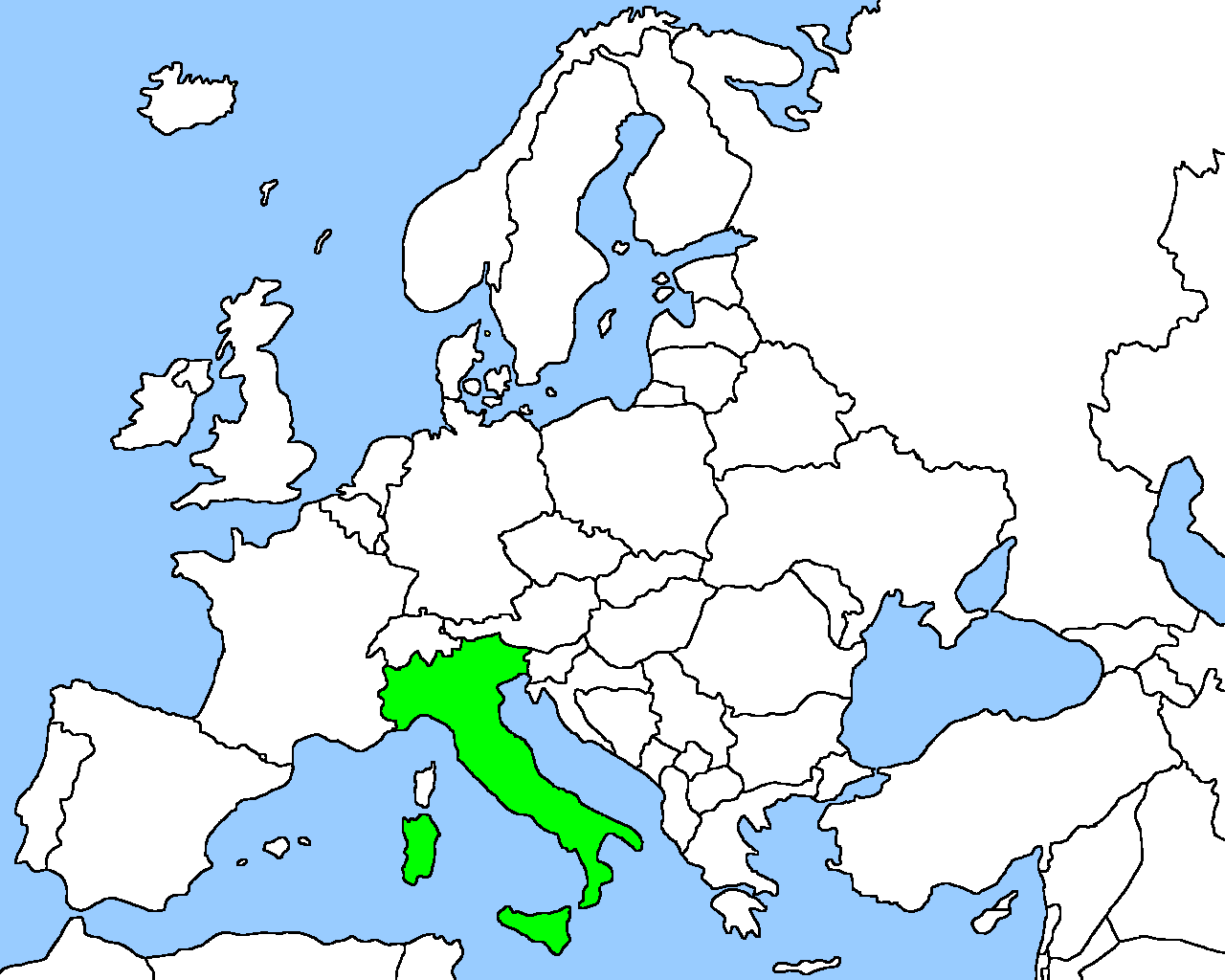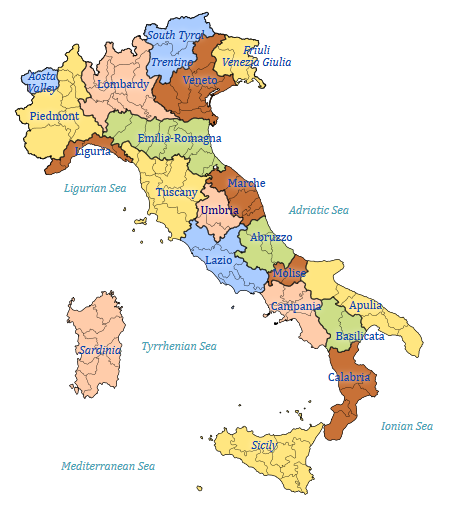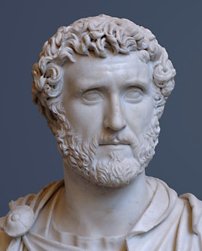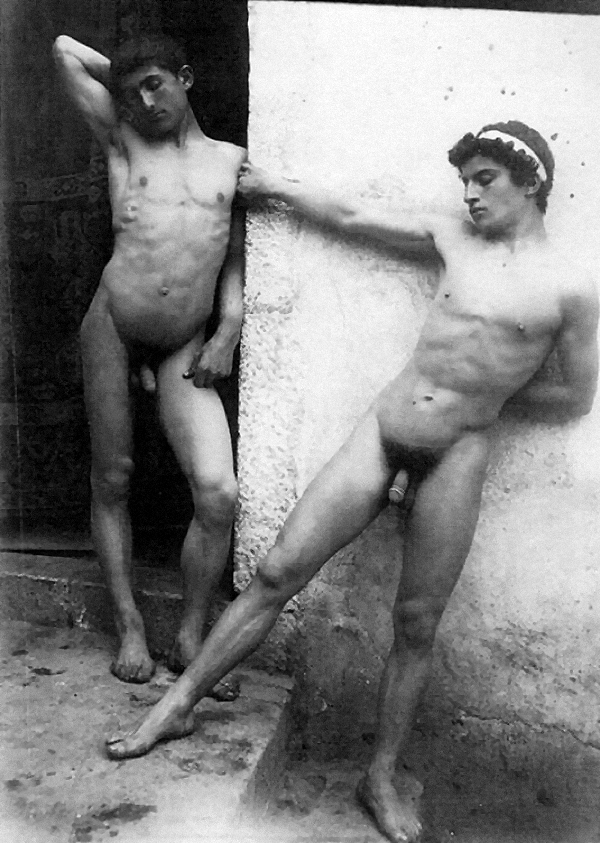Italy is a largely maritime peninsula in the Mediterranean Sea, separating the Mediterranean from the Adriatic, with two substantial island provinces, Sardinia and Sicily. On land, it borders France, Switzerland, Austria and Slovenia - most for very short distances.
 |
 |
Italy was the centre of the Roman Empire, the dominant force in Europe in late classical times. Following the collapse of the Roman Empire, Italy became fragmented into many different states in mediaeval times. Some of these came under foreign control - Spain in the south, France, Austria and Prussia in the north. The very wealthy maritime trading city-state of Venice always maintained its independence. In the mid-19th century there was a strong move towards Italian unification, and in 1861 a unified Italian state was proclaimed, though it took a few more years to incorporate Venice and the Papal States. (The Pope was not at all pleased by the latter development.) Unification was the key to the development of modern Italy as a major industrialised nation. It is now the world's 8th largest economy.
The Roman Empire
Circumcision was anathema to the Romans. Public nudity was the norm at the gymnasium, public baths, and athletic sports. These were not just places where you got clean and fit, they were also important social meeting places where much business was transacted. An exposed glans was regard as most unseeemly. However circumcision was not actually banned for most of the Roman period. It continued in Egypt and Judea under Roman rule. Jews living in the Roman Empire had to pay a special tax, the fiscus Iudaicus which not only permitted them to practise circumcision, it also absolved them from worshipping the Emperor and the Roman gods. The question of whether Christians did or did not need to be circumcised was an important issue in the early Church, but for those living under Roman rule circumcision was enough to enable them to pass as Jews and escape persecution. Paying the fiscus Iudaicus was distinctly preferable to being thrown to the lions.
Things changed with the two Jewish revolts against Roman rule. The first, in AD 70, resulted in the destruction of the Temple in Jerulsalem. The second, in AD 134, was led by Bar Kokhba, who was regarded by his followers as the Messiah. Some claim that it was sparked by Emperor Hadrian banning circumcision, but the evidence for this is slight and disputed. The result was dramatic - Jews were banned from Jerusalem. Until this point relations betwen circumcised Jewish Christians and Judaism had been cordial, but Christians could obviously not accept Bar Kokhba as the Messiah. From then on uncircumcised Gentile Christians were in the ascendancy and many of them occupied Jerusalem.
Whatever Hadrian had or had not decreed, his sucessor Antoninus Pius passed a law restricting circumcision to Jews, and a doctor who circumcised a non-Jew faced the death penalty. The intent of this was to prevent Jews forcibly circumcising non-Jewish slaves (as prescribed by scripture). Many boys in the slave market doubtless breathed sighs of relief.
Bust of Emperor Antoninus Pius, courtesy Britannica
Mediaeval, Renaissance and Baroque.

In most of the Italian states in the fragmented post-Roman times circumcision was something only practised by the Jews (who were numerous, and not persecuted). But in the south, Sicily became Muslim from the 9th to the 11th century, and circumcision became routine. The practice still persists, and reader Angelo reports that the circumcised men may be Muslim or North African in origin, but are now totally Italian in their ways.
Baron Wilhelm von Gloeden was a German aristocrat, artistic by temperament, who suffered from tuberculosis and was advised to move to a warmer climate. He settled in Taormina, Sicily in 1877 and took up photography, eventually abandoning painting. He became a world-famous photographer, largely responsible for putting Taormina on the tourist map. His images included landscapes, village scenes and male and female nudes, but it is the images of boys, adolescents and young men that form the bulk of his output.
Wilhelm von Gloeden, (1856-1931) Due ragazzi, catalogue # 0078
Several of these pictures show circumcised men and boys and while one shows a man who looks to be North African, others such as this picture - Two Boys (or Two Teenagers) - are clearly of locals. It is obvious that the young man on the right is circumcised, the scar is visible, while the one on the left, as we can see more clearly in other images, has a short foreskin which just comes over the rim of the glans. More from von Gloeden later.
At the opposite end of Italy, in the north-west corner on the Adriatic coast, is the magnificent city of Venice. Venice was a very rich state, thanks to trade routes crossing the whole of the known world and its closeness to the wealthy markets of the Austrian Empire. Venice was a republic ruled by the aristocratic families listed in the "Golden Book". The Doge was a largely titular head of state. Marriages had to be carefully arranged so that the sons would still be in the Golden Book and therefore eligible to be senators. (There was also a second list, the Silver Book, of the lower tier with whom some intermarriage was allowed).
By the 18th century Venice was also legendary as a centre for sexual licence, gambling and debauchery. The Venice Carnival was as famous as Rio's is today. It has been claimed that the upper classes were circumcised and that this was an important part of the Venetian ars amandi (art of love) (Ref. 2). Venice was unshakeably Christian, tracing its Christian history back to St Mark, so where this came from is unclear - possibly the Coptic Church with whom they would have had extensive trading relationships.
Circumcision in Italy today
From Umberto Eco's novel Foucault's Pendulum:
BELBO: Our Diotavelli thinks he's Jewish.
DIOTAVELLI: What do you mean, 'thinks'? I am Jewish...
BELBO: Diotavelli, a person can't just decide to be a Jew the way he might decide to be a stamp collector of a Jehovah's Witness. Jews are born. Admit it! You're a Gentile like the rest of us.
DIOTAVELLI: I'm circumcised.
BELBO: Come on! Lots of people are circumcised, for reasons of hygiene. All you need is a doctor with a knife. How old were you when you were circumcised?
DIOTAVELLI: Let's not nitpick.
This quote tells us two things. In 1989 it was common for Italians to be circumcised for health reasons, but this didn't usually happen in infancy when Jewish circumcision is performed.
Italian readers Roberto and Alessandro tell us that the current Italian circumcision rate is between 13% and 15%. Many young men are circumcised during their compulsory military service, where it is both free and readily available. The general feeling is that the rate is on its way up. More recently (2019), reader Davide, circumcised in infancy and now aged 37, tells us that in his school class of 15, 5 (including him) were circumcised. It seems clear that in Italy circumcision is becoming more and more popular.
Italian Art

A much-discussed topic of Italian art in the Renaissance and Baroque periods is that Jesus, Isaac, John the Baptist and David are all depicted as uncircumcised even though everyone knew that they were circumcised. The Feast of Christ's Circumcision was a major Church festival, and depictions of the circumcision were common. (See our Circumcision in Art page.) Here is an even stranger example.
An Italian brass Hanukkah lamp, 19th century, from Sothebys "Important Judiaca" auction, 4th Dec 2014, New York. Click image for full-size version. (Opens in new window - close to return.)
This is a Jewish symbolic item - a lamp to be lit for Hanukkah, the Festival of Candles, which celebrates the succesful revolt of the Jews, under Judas Maccabeus, against the Hellenistic Seleucid Empire in 164 BC. (The name Hanukkah means "dedication" and refers the re-dedication of the Temple in Jerusalem.) Two cherubs frame the sculpture - and both are uncircumcised! Judaism is generally opposed to nudity - maybe Christianity would be too had the Gentile branch not prevailed - so nudity is rare in Jewish art. But for a Jewish symbolic item to show boys with foreskins is extraordinary.
There is another peculiarity in the legendary Italian art of the Renaissance and Baroque. Classical Roman and Greek art notoriously portrayed adult men with juvenile penises (see the relevant page in Circumcision in Art). What has not been documented until now is a double standard in Italian Renaissance art, whereby boys (up to the appearance of pubic hair) were depicted naturalistically, but adult men were forced to comply with the ancient Graeco-Roman model. An entertaining recent paper reveals this.
The images of boys and men from Italian Renaissance art are compared with photographs of boys and men from the late 19th century photographs of Wilhelm von Gloeden. These people were still living a simple agricultural life unchanged from Renaissance and Baroque times, and so would look like the models who posed for Michelangelo and Caravaggio. Here are a few examples - see the full paper for more.
It looks like a pretty convincing argument. One question that is raised in the paper is how much this has given rise to misconceptions about what the adult uncircumcised penis looks like. Most American anti-circumcision campaigners have probably never seen one, and if museum art is their idea of what they look like, they are seriously deluded.
References
Rabello, Alfredo Mordechai, 2015. The Ban on Circumcision as a Cause of Bar Kokhba's Rebellion. (Hebrew original in Isr. L. Rev. 29, 176, 1995). English version available through SSRN.
Munter, Fritz, 1981. Radical circumcision, yes or no? H&E Monthly 81(6) 2-7
Umberto Eco, Foucalt's Pendulum. (trans. William Weaver; New York, Ballantine Books, 1989). pp 65-66
Guy Cox, 2016. The Prepuce in Italian Art - Evidence from Von Gloeden's Photographs. Open Access Library Journal, 3, e2898. Free download.
Wikimedia Gloeden Catalogue
Acknowledgements
Wikipedia - maps and backgound information. Information from Circlist contributors, especially Roberto and Alessandro






